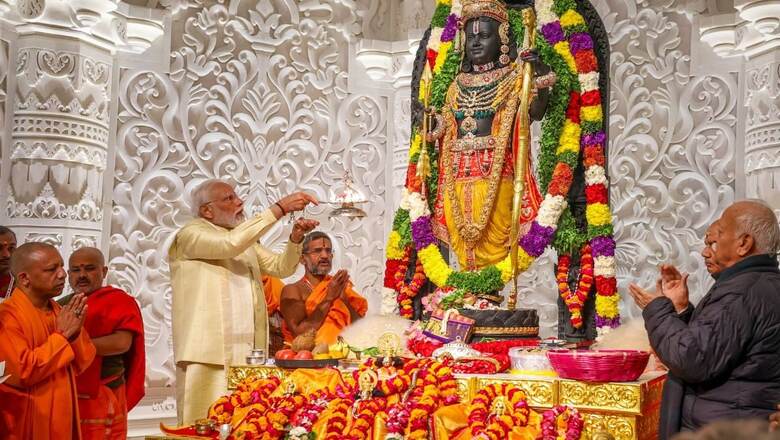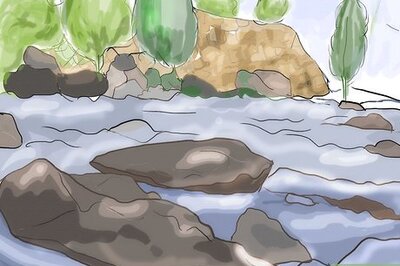
views
The moment of Ram Lalla’s ‘pran pratishtha’ on January 22, 2024, could have gone two ways.
First, the usual way as any other high-profile event in January. There are several such events throughout the year and, more so, in January – National Youth Day (January 12), Parakram Diwas (January 23) and Republic Day (January 26), to name just a few. This approach was the relatively simpler option.
The second way was significantly much tougher – unite the entire country. Across classes, from those living in penthouses to people living in tents; across regions, castes, demography; generate a unique and unparallelled festive celebration across the country; ignite a sense of civilisational fulfilment in the entire population.
Despite best intentions, it could all have gone the first way. But, we know that what panned out is not just the second way but a phenomenon that none could have imagined. How did this happen?
The main reasons behind this are the ‘sadhana’ and ‘tapasya’ of Prime Minister Narendra Modi and the ground mobilisation of the RSS. First consider what the prime minister has done since the beginning of this month.
From bhajans to 11-day ‘anushthan’
It all started innocuously, or so it would seem on January 3 with Prime Minister Modi posting a Ram bhajan. And then he also posted on January 4 and 5, and then again and again. This one simple act was a catalyst that broke the self-restraint of Ram bhakts, mentally ingrained through decades or even centuries of conditioning. It was no longer uncool to proudly proclaim our reverence for the ‘maryada purushottam’ in the lingua franca of the masses.
The bhajans and songs that the PM posted soon became a national rage, igniting a chain of all forms of digital adoption. New bhajans were written and shared, old ones started topping national charts and, in a matter of days, the airways were echoing with ‘Ram aayenge’.
Then came PM Modi’s 11-day special ‘anushthan’ that began on January 12 from the Panchavati dham in the holy city of Nashik. The ‘yama-niyama’ that he committed to in the run-up to the ‘pran pratishtha’ entailed strict adherence to moral and ethical conduct. At 73 years of age, with hectic duties of the office of the PM, that Modi would choose to uphold the mandate of the scriptures, galvanised the entire nation – from sages to gurus and from ordinary people to celebrities in blessing him in his ‘yug anushthan’. He not only gave up grain for 11 days, but slept on the floor and observed the entirety of the ‘yama-niyama’ mandate.
And, with the beginning of the ‘yama-niyama’ came the 11-day crisscross across our sacred geography. Uniting all our people, even with their differing traditions, worship methods, languages, local culture, practices into one common, unbroken chain of the oldest continuously living human civilisation. The ambition of this endeavour was audacious.
On January 12, Modi was in Kala Ram Mandir in Panchavati. It is believed that this temple is located at the same spot where Ram stayed with Sita and Laxman. He offered prayers at the temple and listened to the ‘Bhavartha Ramayana’ written in Marathi. It is from this place that Modi also started the cleaning drive in temples across the country.
On January 14, an auspicious day across India, Modi undertook ‘gau puja’ at his residence in Delhi. Revered by Hindus since time immemorial, Gaumta along with Ram have been accepted as foundational to Sanatan Dharma. From our sacred texts to Mahatma Gandhi, all have averred to this faith and belief. The same day, he also took part in Pongal celebrations.
On January 16, Modi visited Lepakshi temple in Andhra Pradesh. Located near the well-known spiritual town of Puttaparthi in Anantapur district, this village is famous for the temple constructed for Veerabhadra, the fiery incarnation of Shiva and the divine bird Jatayu.
Lepakshi, which means ‘Rise, oh bird’ in Telugu, is intricately connected with Ramayana. It is believed that it is at this place, Ram and Laxman met the grievously injured Jatayu and gave agni to its mortal remains. In this temple, Modi chanted bhajans and heard verses from the ‘Ranganatha Ramayana’, the Telugu rendition of the Ramayana.
Modi later performed aarti and puja at the Veerabhadra temple, followed by a puja to Durga and Shiva in the temple premises. Later, a TTD (Tirumala Tirupati Devasthanams) team of Carnatic music artistes rendered Ram bhajans while artistes from Nimmalakunta in Dharmavaram mandal of Satya Sai district performed a puppet show on the Ramayana.
On January 17, Modi was first in Guruvayur temple in Kerala. Dedicated to Guruvayurappan, a form of Vishnu, but locally more popularly as Krishna. Ram is known to be the seventh avatar of Vishnu. This is one of the holiest temples for devotees from the southern states.
Modi prayed at this temple, observing all the formalities, including wearing the prescribed ‘vastram’ of ‘mundu’ and ‘veshti’. At the temple, he performed a ‘thulabharam’ (an offering) with lotus buds.
On the same day, Modi also visited the Thriprayar Shree Ramaswami temple in Kerala’s Thrissur district. The temple is called ‘Dakshin Ayodhya’. Devotees believe that Karimpuzha, on whose banks this temple is located, is the Sarayu river that flowed through Ayodhya in the Treta Yuga.
Ram is believed to have renounced his life here by entering the waters of Karimpuzha and devotees believe that it is the same as Sarayu; poet-saint Thunchaththu Ramanujan Ezhuthachan is believed to have stayed in the premises of this temple while composing his epic ‘Adhyatma Ramayana’. The Thriprayar temple is one of the four in the Nalambala Darshanam (four-temple pilgrimage), where devotees go on a pilgrimage to four temples devoted to Ram, Lakshman, Shatrughan and Bharat during the month of ‘Karkidakam’, also known as month of Ramayana.
Apart from offering prayers as per all rituals and practices, Modi, in the one hour he spent at the temple, attended a Vedic chanting session of children and various bhajans in Malayalam. He also took part in the ‘meenoottu’ ritual (offering food to fish).
On January 18, Modi released a series of commemorative postage stamps dedicated to the Ram Janmabhoomi Mandir in Ayodhya and an album featuring stamps from around the world in honour of Ram. The intricate design of the stamps captures the essence of the temple, with six distinct components: the Ram temple itself, the timeless ‘choupai’ ‘Mangal Bhavan Amangal Hari’, a radiant depiction of the sun, the sacred Sarayu river, and sculptures found in and around the temple.
On January 20, he visited two temples and holy places innately connected with Ram. First, he visited the Ranganathaswamy temple at Srirangam in Tamil Nadu’s Tiruchirappalli. It is believed that at this exact place Vibhishana placed the family deity of Ram in a reclining posture, which is also worshipped to this day. Modi was the first prime minister to visit the place.
On his arrival, Modi was accorded a ceremonial ‘purna kumbha’ welcome amid Vedic chanting. Honouring our great traditions, the PM listened to the recitation of verses of the ‘Kamba Ramayanam’ by scholars at the temple. In fact, he sat at ‘Kamba Ramayana Mandapam’, believed to be the very place where Kamba first sang the Tamil rendition of the epic Ramayana.
Modi also spent some heartwarming moments with the resident temple elephant ‘Andal’, who not only blessed the prime minister but also showcased his musical skills by expertly playing the harmonica. During his visit, ‘vastram’ and clothes were presented to Modi, a traditional way of a temple acknowledging a devotee’s devoutness. On behalf of the presiding deity, the priests at the ancient temple presented him with a special gift basket to be taken to Ram in Ayodhya. The basket comprised different local handlooms and fabrics.
On the same day, Modi visited the Ramanathaswamy temple in Rameswaram. It is here that Ram is believed to have installed the main lingam of Shiva. It is one of the four dhams in Sanatan Dharma and also one among the 12 jyotirlingas. There are 22 kunds in this temple indicating 22 arrows in Ram’s quiver. Bathing in these is part of the ritual and Modi did exactly that. One by one, he went to each kund and took the holy bath, starting with ‘Samudra Snanam’ at Agni Tirtham and Modi, like every other devotee, also started his journey by taking a bath in the Bay of Bengal. Later, he took part in Shri Ramayana Paryanam, listening to eight different traditional mandalis reciting Ramkatha (recounting the episode of Ram’s return to Ayodhya) in Sanskrit, Awadhi, Kashmiri, Gurmukhi, Assamese, Bengali, Maithili and Gujarati.
Finally, on January 21, Modi visited two places: first, Arichal Munai near Dhanushkodi in Tamil Nadu. This is the exact place from where the Ram Setu was built. As the prime minister said in his speech after the ‘pran pratishtha’ in Ayodhya, it is building this bridge that heralded the change of an era and the beginning of a new one. Modi paid floral tributes at the spot and performed pranayama.
Later, on the same day, the PM visited Kothandarama Swamy temple in Dhanushkodi. It is believed that at this place, Vibhishana first met Ram and asked for refuge. It is also the place where he was crowned the king of Lanka. Modi prayed at the temple and took blessings. This was Modi’s ‘tapasya’ before he could gather enough blessings or ‘punyaya’ to be able to perform the ‘pran prathistha’ on January 22.
Ground mobilisation by RSS
At the same time, the ground force of crores of selfless volunteers of the RSS were visiting homes distributing the holy ‘akshat’ — a simple act that electrified the whole nation. People touched the feet of the volunteers who came with the ‘akshat’, others cried, and still others mobilised their entire societies in festive brilliance to mark the act of receiving the ‘akshat’. There was no class or caste barrier, neither did anyone ask nor offer to tell their social status. All that mattered was the pious act of taking and giving the ‘akshat’.
Had January 22 been just another event, no matter how grand, the fervour we have today would not have happened. It would have been like an important milestone, but one among many. One that comes every few years and passes. But, this is where the genius of PM Modi lies. In seizing the moment, his ‘tapasya’ and ‘sadhana’, the entire of January and the humongous mobilisation by the RSS gave us the civilisational moment that we all dreamt of.
The inner satisfaction we are feeling today, at having a moment befitting the enormity of the occasion, is in equal measure the result of the ‘yagna’ of both the society and the leadership. The Bhartiya society, at large, is on the verge of rediscovering its original moorings. This rediscovery is destined to ignite the revival of a glorious phase in our civilisational history.
Some argue that this moment has come after five centuries. True, but there is another truth. Our generation is lucky to have exactly the same feeling that people in Treta Yuga would have felt after Ram’s return. Each generation with every passing year, has only celebrated Diwali. It is only us, in this generation of 2024, who are blessed enough to have the same sense of fulfilment that the residents of Ayodhya felt multiple millennia ago.
It then behooves us to utilise this opportunity to unitedly work for a multiple millennia of Bharat’s pre-eminence, just as it happened the last time Ram returned.
(The writer is the founding CEO of BlueKraft Digital Foundation. Views expressed in the above piece are personal and solely that of the author. They do not necessarily reflect News18’s views)














Comments
0 comment